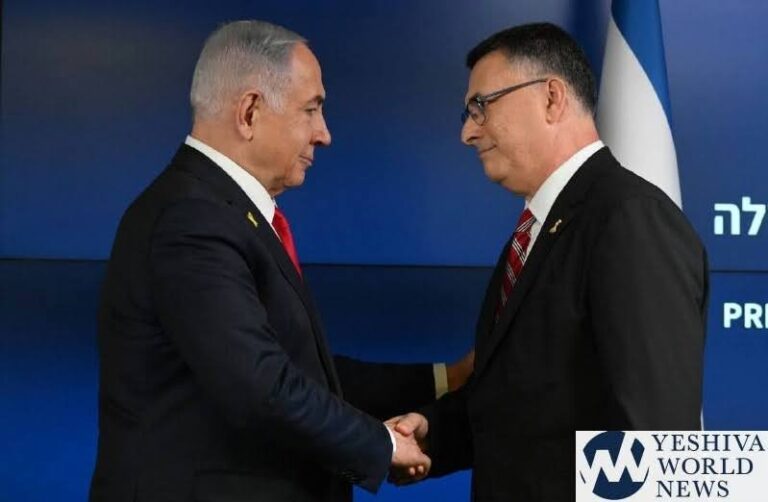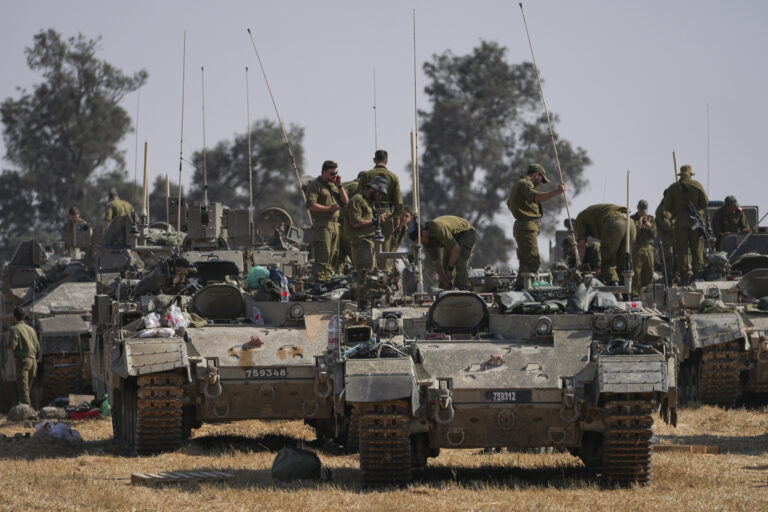Police cars line the approach to Marjory Stoneman Douglas High School. They sit at all four corners of the crossroads of Coral Springs Dr. and Holmberg Rd., dotting the road ahead, and in the school parking lot, beyond the chain link fence and the yellow crime scene tape stretched thin around the perimeter. At night their flashing lights illuminate the area, like blue and red memorial candles for the dead.
Seventeen markers with the names of the deceased have been set up at the top of an embankment on the street-side of the school fence, and even as the time nears midnight, men and women, teenagers and children, approach, lay flowers, light candles, and quietly contemplate the events and consequences of Feb. 14.
The nature of tragedy is to shake people, to cause them to step back and recognize what is most important in life and what is less so—heightening the the sanctity and fragility of the human experience—helping people to regain perspective on what the purpose of it all is. Amid the confusion, a greater clarity emerges.
Thus in a quiet, no-frills meeting held with Florida Governor Rick Scott at his request early Monday morning, the Chabad-Lubavitch rabbis of Parkland and Coral Springs laid out a series of ideas to help harness the emotions and the outpouring of love being experienced into long-term change. Chief among the rabbis’ proposals was for a “Moment of Silence” in classrooms throughout Florida’s public school system, a minute or two each morning to start the day with silent contemplation.
The delegation of rabbis was led by Rabbi Yosef Biston, founding director of Chabad of Parkland, and a leader in the South Florida Jewish community since in 1975; and Rabbi Yossie Denburg, dean of Hebrew Academy Community School in nearby Margate and senior Chabad emissary in Coral Springs.

A ‘Moment of Silence’
“A voluntary ‘Moment of Silence’ means taking 60 seconds, and saying ‘Today, think about what you can do to be a better student,’” Denburg explained to the governor. “‘Today, think about what you can do to be a better human being.’”
Having championed the need for moral education in all schools—both public and private—the Rebbe, Rabbi Menachem M. Schneerson, of righteous memory, began discussing the “Moment of Silence” by name in 1983.
“[A] person has the ability to influence his surroundings, extending eventually to the country and to the whole world, making the world a stable, productive place,” he explained in a 1984 talk given for his 82nd birthday. “… Th[is] begins with the proper education of the youth, as written: ‘Educate a youth according to his way so that when he grows older he will not depart from it.’ The only way to educate the youth in the ideals of justice and righteousness is not through instilling fear of the police (for then one can think he will outwit the police), but by instilling faith in the Creator and Ruler of the world—that there is ‘an Eye that sees and Ear that hears.’”
While the Rebbe saw a “Moment of Silence” as a way to accomplish this, at the same time he highlighted the necessarily non-sectarian nature of the moment, explaining that “if the law were to establish a spoken acknowledgement of G‑d, then, even with full provisions for neutrality concerning any particular religion, nothing can assure that the teacher or principal will not exert some pressure on the students concerning a particular religious belief,” hence a “Moment of Silence” was in fact preferable to any spoken prayers in a public school setting.
The Rebbe also added that this simple, daily act would hand responsibility for a child’s emotional and spiritual wellbeing back where it belonged, with his or her parents. “Another advantage to a ‘Moment of Silence’ specifically is that it will force parents to take part: They will have to tell their child what to think about during the ‘Moment of Silence’ — about the Creator and Ruler of the world. Parents will therefore send their child to school equipped not only with physical food but also with spiritual food.”

Is It Legal?
Because of its inherently non-sectarian and secular nature, “Moment of Silence” has confidently weathered litigation and is currently permitted or mandated in 34 states. One judicial setback was Wallace v. Jaffree (1985), when the U.S. Supreme Court ruled that Alabama’s state law overstepped the boundaries of the permissible in the wording and intent of their statute. (The Rebbe referred to the Alabama ruling in a 1986 talk on the subject, stating that it was good that this particular law was overturned for it “might create a scenario where a teacher or superviser could impose his particular form of prayer, or his religion’s version of prayer on the students—something which would be wholly unacceptable.”)
According to the Pew Research Center, it was Justice Sandra Day O’Conner’s “concurring opinion that has influenced subsequent lower court decisions,” since O’Conner wrote that “she would have upheld the Alabama law if the legislature had shown a genuine secular purpose in passing it. Indeed, she explained, school-led moments of silence, unlike school-led prayers, are often permissible because they are not inherently religious and do not coerce participation in a religious act.”
In fact, the State of Florida already has a Moment of Silence law on the books, statute 1003.45 stating “The district school board may provide that a brief period, not to exceed 2 minutes, for the purpose of silent prayer or meditation be set aside at the start of each school day or each school week in the public schools in the district.”
During the 40-minute-long working meeting, the rabbis provided Gov. Scott with studies and other written materials on the goals of Moment of Silence, and its role in fostering students’ moral education, which he carefully reviewed and noted.
While Moment of Silence is legal, it is not always actually instituted, even in states where it is mandatory by law. A growing body of evidence from scholars attests to the concept’s positive impact on the student body, although none of it more powerful than testimony of principals where it has had a tangible impact. The rabbis highlighted one particular school, P.S. 191-The Paul Robeson Elementary School in Brooklyn, N.Y., offering a synopsis written by that school’s administration regarding their experience.

“When we introduced it several years ago overall student attendance was down, parent participation was low, and student achievement was climbing but not at the rate that everyone was hoping for,” the 2013 paper reviewed by Scott reads. “Our students required, and still require, a greater need to be listened to. Our students required new ways of dealing with emotions and crisis. Our students needed the time and an outlet that would provide an opportunity to understand the ‘whys’ and ‘hows’ of their experiences. They needed to become more contemplative …
“Since then it has become an ongoing, transformative experience. The Moment of Silence provided the students an opportunity to become more mindful and reflective of their experiences inside and outside the classroom. The students have become more introspective in their writing and have a greater appreciation, empathy, and understanding of their peers … Students have also gained a greater understanding of educational objectives.”
“The impact on the kids has been to the extent that some have been doing it on weekends,” explained Rabbi Shuey Biston, who also attended the meeting. Biston, director of outreach at Chabad of Parkland, has been counseling, praying and attending to the needs of grieving families since last week almost without break. “It sets the tone for the rest of the day.”
The meeting was also attended by Rabbi Avraham Friedman, director of Chabad of Coral Springs, who later in the day reiterated much of what he shared with the governor nationally when he appeared on CNN; and Coral Springs Rabbis Moshe Rabin, Yanky Denburg, and Hershy Bronstein.
Among the other proposals brought in front of Gov. Scott was something they called Club 17, student groups encouraged by high school administrations with the purpose of building student communities revolving around good works and volunteering projects; and a Big Brother/Big Sister type program among students themselves.

Memorials for the Victims
The Parkland Amphitheater and field sits in the heart of Pine Trails Park and was the site of last week’s mass memorial. Like the fence at Douglas High, flowers, candles, and placards fill the area, drawing people of all ages, especially teenagers, who slowly wander the field, pausing at makeshift memorial after memorial set up for the victims.
Inside the adjacent Parkland Recreation and Enrichment Center, three Walls of Goodness and Kindness were set up by the students of the Rohr Bais Chaya Academy High School last week. They are dotted with multicolored sticky notes with personal commitments of good deeds in the memory of the fallen, with more being added each day.
As Biston showed pictures of the wall on his phone to the governor, Denburg said that they would like to see such walls erected by students at all high schools, not just in the aftermath of this tragedy, “but permanent Walls of Kindness where kids can place notes of things they are going to do for their communities.”
During the meeting, the governor stated, and the rabbis agreed, that practical safety measures have to be taken in light of the recent tragedy, a necessary reaction to the horrible events at Douglas High School and to the ever-increasing death toll in mass shootings.
“Not to take away, G‑d forbid, from the gun conversation, the mental health conversation, the security conversation,” Biston told Scott as the governor jotted notes.

“Such steps are very important, and no one would want to minimize the need for concrete steps in that area,” says Friedman following the meeting. Like Biston, he stresses that debate around additional gun control, added security at schools, better provisions for mental health care, or a combination of all of the above, is an important one. But it should not be the only one being had.
“What we are trying to do here is be proactive, go to the heart of the matter, and not just be reactive to the tragedy,” he says.
“As a result of instituting this ‘Moment of Silence’ in the public school systems, the authorities will save steps in their search for ways of dealing with all the serious problems in the schools,” the Rebbe said in 1986, long before the school shooting epidemic of our day. “The more serious and shocking problems will be solved as well as the less serious problems, which in these troubled times leave so many children permanently hurt and scarred by their negative experiences in the school world.”
Preparing for the Minchah prayer at the Alhadeff home in Parkland later that day, Rabbi Yossi Biston looked at the pictures of 14-year-old Alyssa, murdered last week. She smiles out of the photos, with her parents, her brothers, her soccer team. A young life, bursting with hope and promise for the future, tragically taken.
“Is this normal?” he asks, pointing at the photos. “This is a not a normal place for the world to be in. We have to get to work now.”


(Source: Chabad.org)












One Response
I want to cry.